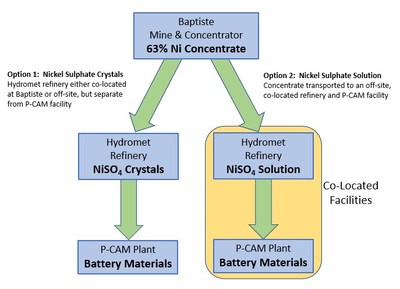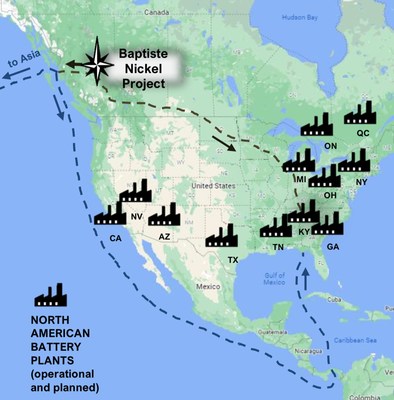FPX Nickel Announces Scoping Study for Production of Nickel Sulphate from Baptiste Project in British Columbia
VANCOUVER,BC, Feb. 1, 2022 /CNW/ - FPX Nickel Corp. (TSXV: FPX) (OTCQB: FPOCF) ("FPX" or the "Company") is pleased to announce that it has commenced an internal scoping study to further evaluate the option to produce nickel sulphate for the electric vehicle ("EV") battery supply chain from the high-grade nickel concentrate produced by the Company's Baptiste Nickel Project ("Baptiste" or "the Project") in central British Columbia. This study incorporates the positive results of previous leaching testwork on the clean, high-grade Baptiste nickel concentrate (63% nickel), which confirmed the Project's potential to be a significant supplier of high-purity feedstock for the EV battery market.
"We expect this scoping study to demonstrate that Baptiste could become a globally significant producer of low-cost, low-carbon nickel for electric vehicles for decades to come," commented Martin Turenne, FPX's President and CEO. "Baptiste's awaruite nickel mineralization has clear technical advantages over sulphide and laterite ores for producing nickel sulphate, owing to the extremely high nickel content and low levels of impurities in the nickel concentrate produced in previous metallurgical test programs."
"Our scoping work will evaluate the potential for the production of low-carbon, battery-grade nickel sulphate from awaruite mineralization in a simple three-stage process encompassing beneficiation, pressure leaching, and solvent extraction," continued Mr. Turenne. "This three-stage processing route has the potential to be more efficient and entail lower cost and carbon emissions than the typically more complex processes required to convert sulphide and laterite ores into nickel sulphate, as shown in Figure 1 below."
Previous Testwork
Nickel mineralization at Baptiste is primarily present in awaruite (Ni3Fe), a nickel-iron alloy composed of 75% nickel and 25% iron. Nickel occurrence as awaruite ranges from 83 to 92% at Baptiste, with the balance occurring as nickel sulfide minerals, primarily pentlandite. Awaruite's high nickel tenor (75%) uniquely allows the production of an extremely high-grade flotation concentrate. Awaruite's distinct characteristics of ferromagnetism, density, and active surface properties allow the use of a conventional process flowsheet using grinding, magnetic separation, and flotation. This simple flowsheet has been demonstrated to consistently produce high-grade flotation concentrates.
In comparison to typical nickel sulphide concentrates, the Baptiste nickel flotation concentrate is notable for its extremely high metal content and low level of sulphur and impurities, as shown in Table 1.
Table 1 – Select Elemental and Mineral Content for Baptiste Nickel Concentrate and Typical Nickel Sulphide Concentrate
Elements and Minerals | Baptiste Awaruite Nickel Concentrate | Nickel Sulphide Concentrate |
Nickel (Ni) | 60-65% | 8-21% |
Iron (Fe) | 30-32% | 25-41% |
Sulphur (S) | 0.6% | 14-31% |
Cobalt (Co) | 1% | 0-1.2% |
Copper (Cu) | 0.7% | 0-2.2% |
Magnesium Oxide (MgO) | 1% | 4-10% |
Baptiste's awaruite nickel mineralization has significant technical advantages over sulphide and laterite ores for producing nickel sulphate, as follows:
- The efficient dissolution of Baptiste's high-grade concentrate can eliminate the need for intermediate smelting prior to downstream hydrometallurgical processing into nickel sulphate, as required when treating conventional nickel sulphide concentrates.
- Leaching of Baptiste's high-grade concentrate feedstock requires a tangibly smaller pressure leaching footprint using significantly lower pressure and temperature than the high-pressure acid-leach ("HPAL") process used in nickel laterite operations.
As described in the Company's January 7, 2020, news release, batch pressure leach tests of Baptiste's nickel concentrate were undertaken at Sherritt Technologies's lab in Fort Saskatchewan, Alberta. These tests were conducted with pressure and temperature conditions selected to approximate the proposed commercial conditions.
Based on these test results, it is expected that the pregnant leach solution produced from leaching Baptiste's flotation concentrate will be an ideal feedstock for the production of nickel sulphate. The low levels of impurities (notably iron) in the pregnant leach solution suggest that downstream refinement into sulphate products would require a relatively simple process with favourable operating parameters. Confirmation of these downstream processing steps is subject to future testing, including testwork currently being conducted by FPX, the results of which are anticipated in the third quarter of 2022 (see the Company's December 8, 2021 news release for a description of the ongoing metallurgical test program).
For reasons noted above, leach equipment sizing and operating parameters for Baptiste's nickel concentrate is potentially favourable to those in typical HPAL operations treating laterite ore, such as the Ramu Nickel Cobalt Operation in Papua New Guinea ("Ramu"). Table 2 below provides a comparison of pressure leaching parameters for the treatment of Baptiste concentrate (based on the testwork described in the Company's January 7, 2020, news release) and laterite ore at Ramu (which has been in operation since 2012).
Table 2 – Pressure Leaching Autoclave Parameters for Baptiste Concentrate and Ramu Nickel Cobalt Operation
Autoclave Parameter | Baptiste Concentrate (Conceptual Based on Testwork) | Ramu Nickel Cobalt Operation (Note 1) |
Feedstock type | Flotation concentrate | Whole ore |
Feedstock grade | 60-65% Ni | 1.09% Ni |
Pressure | 750 kPa | 4,300 kPa |
Temperature | 150°C | 250°C |
Target extraction rate (recovery) | >98% | >95% |
Target residence time | 60 minutes | 60 minutes |
Note 1 – Source: Design parameters for Ramu Nickel Cobalt Project in Cobalt 27 Capital Corp., NI 43-101 Technical Report (July 19, 2019)
Furthermore, it is expected that a pressure leaching circuit treating Baptiste's flotation concentrate would have much lower feed variability than a typical HPAL plant accepting run-of-mine ore, with the associated more variable nickel grades and mineralization sourced from typical laterite deposits, which can range from 0.7% to 1.7% nickel content (more than 100% feed grade variance to pressure leaching).
Scoping Study
FPX has initiated an internal scoping study to further evaluate a hydrometallurgical refinery to upgrade the high-grade Baptiste nickel concentrate to a product that is readily usable within the EV battery material supply chain. Upstream of EV battery manufacturers are chemical plants producing P-CAM (precursor cathode active material) and CAM (cathode active material) for insertion into the battery cathode cells. These chemical plants require nickel feedstock (typically in the form of nickel sulphate) to produce P-CAM and CAM.
The FPX scoping study (which is expected to be completed in the second quarter of 2022) will evaluate options for producing nickel sulphate in either crystal form (Option 1) or solution form (Option 2), including an assessment of the various technical, economic and strategic considerations of each alternative. Figure 2 below provides a conceptual product flow diagram for each Option's integration into the EV battery supply chain.
Option 1 entails the production of nickel sulphate crystals at a hydrometallurgical refinery to be located either in British Columbia or at another off-site location further afield. The primary advantage of producing nickel sulphate in crystal form (versus Option 2's solution form) is the greater flexibility for transporting the product over significant distance (via truck, rail, or ocean freight) to the chemical plants producing P-CAM and CAM.
Option 2 is based on the transport of Baptiste concentrate to a hydrometallurgical refinery jointly-located with P-CAM and CAM facilities. In this scenario, the hydromet refinery would produce a nickel sulphate solution, which would then be directly fed to an adjacent chemical plant producing P-CAM and CAM.
These two Options are expected to generate high-value alternatives for the utilization of Baptiste concentrate in the EV battery supply chain, both in North America and abroad. Figure 3 shows the potential for logistical integration of Baptiste concentrate into the North American EV supply chain, with multiple transport modes and routes to integrate with the growing number of large-scale battery plants currently in development or operation.
Andrew Osterloh, P. Eng., FPX Nickel's Qualified Person under NI 43-101, has reviewed and approved the technical content of this news release.
About the Decar Nickel District
The Company's Decar Nickel District claims cover 245 km2 of the Mount Sidney Williams ultramafic/ophiolite complex, 90 km northwest of Fort St. James in central British Columbia. The District is a two-hour drive from Fort St. James on a high-speed logging road.
Decar hosts a greenfield discovery of nickel mineralization in the form of a naturally occurring nickel-iron alloy called awaruite (Ni3Fe), which is amenable to bulk-tonnage, open-pit mining. Awaruite mineralization has been identified in four target areas within this ophiolite complex, being the Baptiste Deposit, and the B, Sid and Van targets, as confirmed by drilling, petrographic examination, electron probe analyses and outcrop sampling on all four. Since 2010, approximately US $28 million has been spent on the exploration and development of Decar.
Of the four targets in the Decar Nickel District, the Baptiste Deposit, which was initially the most accessible and had the biggest known surface footprint, has been the focus of diamond drilling since 2010, with a total of 82 holes and over 34,000 m of drilling completed. The Sid target was tested with two holes in 2010 and the B target had a single hole drilled in 2011; all three holes intersected nickel-iron alloy mineralization over wide intervals with DTR nickel grades comparable to the Baptiste Deposit. The Van target was not drill-tested at that time as bedrock exposures in the area were very poor prior to more recent logging activity. In 2021, the Company executed a maiden drilling program at Van, which has returned promising results comparable with the strongest results at Baptiste.
About FPX Nickel Corp.
FPX Nickel Corp. is focused on the exploration and development of the Decar Nickel District, located in central British Columbia, and other occurrences of the same unique style of naturally occurring nickel-iron alloy mineralization known as awaruite. For more information, please view the Company's website at www.fpxnickel.com.
On behalf of FPX Nickel Corp.
"Martin Turenne"
Martin Turenne, President, CEO and Director
Forward-Looking Statements
Certain of the statements made and information contained herein is considered "forward-looking information" within the meaning of applicable Canadian securities laws. These statements address future events and conditions and so involve inherent risks and uncertainties, as disclosed in the Company's periodic filings with Canadian securities regulators. Actual results could differ from those currently projected. The Company does not assume the obligation to update any forward-looking statement.
Neither the TSX Venture Exchange nor its Regulation Services Provider accepts responsibility for the adequacy or accuracy of this release.
SOURCE FPX Nickel Corp.

![]() View original content to download multimedia: http://www.newswire.ca/en/releases/archive/February2022/01/c5521.html
View original content to download multimedia: http://www.newswire.ca/en/releases/archive/February2022/01/c5521.html


